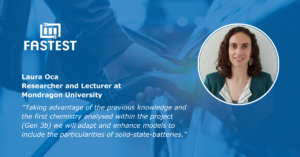
Taking advantage of the previous knowledge and the first chemistry analysed within the project (Gen 3b) we will adapt and enhance models to include the particularities of solid-state-batteries.
Laura Oca is a Researcher and Lecturer of Mondragon Unibertsiy within the Electronics and Computer Science department. She holds a PhD in Applied Engineering specialized in electrochemical device modelling and characterisation of energy storage systems. She is an active part of the Energy Storage Systems Research Group at the university. Her knowledge about modelling and characterization is key for the FASTEST project.
1. Regarding the development of enhanced physics-based modelling tools: How crucial is refining these models to replace physical testing and cut computational time?
One of the commitments of the FASTEST project is to develop different digitalisation approaches, including thermal and ageing contributions (i.e., multiscale multiphysics modelling, data driven modelling and reduced order modelling). This will allow for a reduction of the minimum computational time, memory requirements with the necessary accuracy to replace some physical tests. The development of enhanced modelling tools is one of the core components of the digital twin and virtualization platform inside the project.
2. How do model reduction techniques maintain fidelity while significantly reducing computational time and model size, particularly at the cell and module levels?
The proposed cell and module level reduced-order-models and data-driven models are expected to be adaptable, fast and accurate. We will provide tools for two different chemistries (Gen3b and solid state batteries) therefore showing that we can fastly move into new technologies and designs. Moreover, currently in physical testing environment, to conduct long-lasting tests such as ageing test, would take several months or years. Inside the FASTEST project we propose the implementation of model order reduction techniques and data-driven models to get faster results which will allow to fasten the battery value chain development.
3. How does the project plan to ensure transitions between different battery types, like moving from Generation 3b cells to solid-state batteries? What strategies are in place to continuously enhance model accuracy and computational efficiency throughout the project’s duration?
Within the consortium, we will cooperate with partners with different expertise (battery manufacturers, universities, research centers…) that will allow us to provide a robust methodology for the transition to newer chemistries. Taking advantage of the previous knowledge and the first chemistry analysed within the project (Gen 3b) we will adapt and enhance models to include the particularities of solid-state-batteries.
